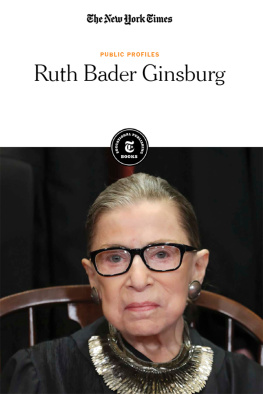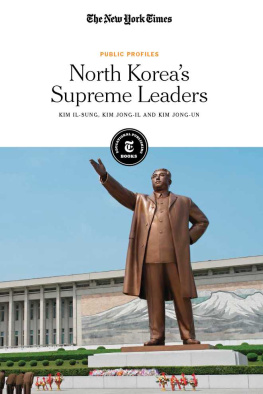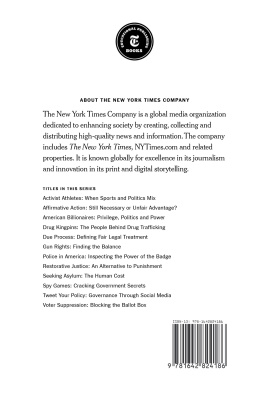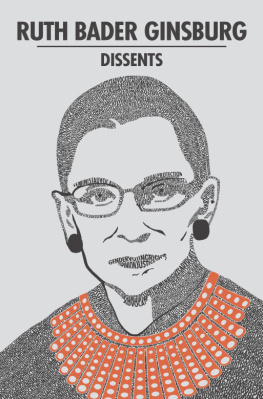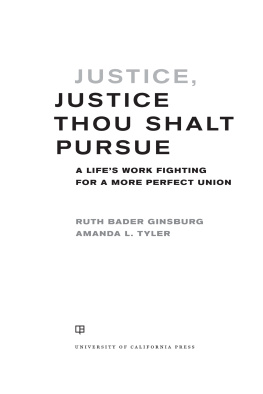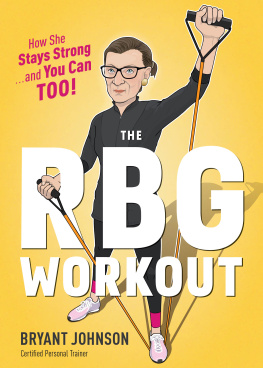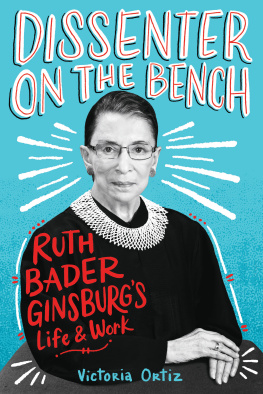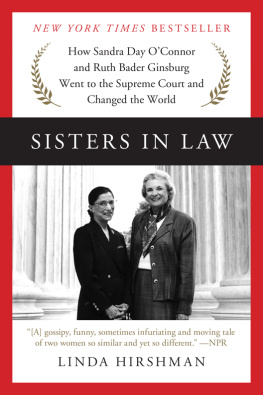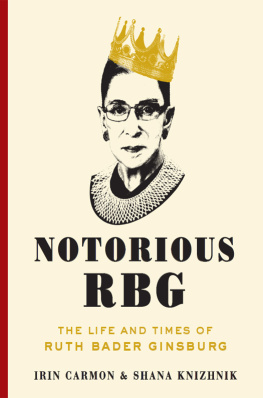Published in 2020 by New York Times Educational Publishing in association with The Rosen Publishing Group, Inc. 29 East 21st Street, New York, NY 10010
Contains material from The New York Times and is reprinted by permission. Copyright 2020 The New York Times. All rights reserved.
Rosen Publishing materials copyright 2020 The Rosen Publishing Group, Inc. All rights reserved. Distributed exclusively by Rosen Publishing.
First Edition
The New York Times
Alex Ward: Editorial Director, Book Development
Phyllis Collazo: Photo Rights/Permissions Editor
Heidi Giovine: Administrative Manager
Rosen Publishing
Megan Kellerman: Managing Editor
Wendy Wong: Editor
Greg Tucker: Creative Director
Brian Garvey: Art Director
Cataloging-in-Publication Data
Names: New York Times Company.
Title: Ruth Bader Ginsburg / edited by the New York Times editorial staff.
Description: New York : New York Times Educational Publishing, 2020. | Series: Public profiles | Includes glossary and index.
Identifiers: ISBN 9781642822458 (library bound) | ISBN 9781642822441 (pbk.) | ISBN 9781642822465 (ebook)
Subjects: LCSH: Ginsburg, Ruth BaderJuvenile literature. | United States. Supreme CourtBiographyJuvenile literature. | JudgesUnited StatesBiographyJuvenile literature. | Women judgesUnited StatesBiographyJuvenile literature.
Classification: LCC KF8745.G56 R884 2020 | DDC 347.732634 Bdc23
Manufactured in the United States of America
On the cover: Supreme Court Justice Ruth Bader Ginsburg poses for the courts official portrait in Washington, D.C., Nov. 30, 2018; Chip Somodevilla/Getty Images.
Introduction
WHEN RUTH BADER GINSBURG attended Harvard Law School, she was one of nine women in her year. One evening during dinner, the dean asked each female student why she was there, taking a spot that couldve gone to a man.
Ginsburg has spent her life putting her education and passion for the legal system to good use despite those who continue to ask that same question. She graduated with top honors from Columbia Law School. She was a professor at Rutgers University, where she taught courses on women and the law, before becoming the first woman to teach full-time at Columbia Law School. She co-founded the Womens Rights Project, a sector of the American Civil Liberties Union. She argued and won gender discrimination cases before the Supreme Court. She served as a federal appeals court judge for Washington, D.C., before taking her place as a Supreme Court justice.
Ginsburgs reserved demeanor masked her fierce resilience and refusal to accept that a womans place was merely as the law described it. She persistently highlighted areas of gender inequality in the law and the ways they hindered both women and men, working to put the sexes on equal footing in all areas of life from the workforce to the home. With each court case she won and law she overturned, she sought to open the eyes of lawmakers and to benefit society with more progressive ideas and values.
Her family is incredibly important to her, serving as the foundation for her accomplishments. Her husband, Marty, and her two children, Jane and James, consistently encouraged her persistence and work ethic. When Ginsburg was a child, her mother, Celia, was a strong role model who disciplined her and taught her the importance of a good education. She was taught to be independent, to think about her decisions and live for herself, not for someone else. She did not believe the sole purpose of her life was to be a wife, mother or caregiver. Her mother also imparted valuable advice, teaching her that words and actions fueled by anger and resentment would only result in a losing battle. Ginsburg took that message to heart, making sure to remain courteous and composed regardless of the unfair comments and treatment she would receive. She wholeheartedly respected the law even as she worked to change it. Although she often disagreed with other Supreme Court justices, she didnt allow any personal feelings to escalate and leave the courtroom. She surrounded herself with people who stood at opposing sides of various issues, forging strong ties with her fellow justices, politicians and social activists.

Ruth Bader Ginsburg in 1972, when she was named a professor at Columbia Law School.
In addition to being a well-respected name in legal and political circles, Ginsburg has become a buzz-worthy pop culture phenomenon. As a result of her much-deserved level of celebrity, shes been introduced to younger generations whove been inspired to learn about who she is and all the things she has done and continues to do to champion equal rights for all. Shes been on both sides of the judges bench, playing crucial roles in important cases that have been the foundation of womens rights and the dismantling of gender discrimination. Even now, she continues to work and push past obstacles like her numerous health problems and calls for her resignation, remaining as focused and passionate as when she first began.
CHAPTER 1
Rising Through the Ranks
As a Harvard Law School student, Ruth Bader Ginsburg became an expert at juggling her schoolwork while taking care of her newborn daughter, Jane, and her husband, Marty, who was diagnosed with testicular cancer. She transferred to Columbia Law School and graduated at the top of her class, only to be rejected by numerous law firms in New York City because of her sex. Her experiences in school, as both professor and appellate court judge, strengthened her fearless approach in confronting gender discrimination, inspiring many in her uphill climb toward what would become the defining role of her career.
Columbia Law Snares a Prize in the Quest for Women Professors
BY LESLEY OELSNER | JAN. 26, 1972
IN A NEW ACCELERATING competition among the nations law schools, Columbia University has just scored a major coup: its law school, to its undisguised glee, has just bid for and won a woman for the job of full professor the first in its 114-year history.
The glee comes in part because the woman, Ruth Bader Ginsburg, is what the schools dean, Michael Sovern, calls so distinguished a scholar, that her credentials and honors would stand out in any catalogue of professors.
It comes too, as the University of Michigan Law School dean, Theodore St. Antoine, says, at a time when many of the countrys best law schools have been scrambling for women, often for the same one. Most have no women at any rung of the professorial ladder, and, according to other sources, the woman Columbia got was among those being scrambled for.
And the glee is likely to spread far beyond the Columbia law faculty and into the law schools, where women students have long sensed an anti-female bias.
The appointment of Mrs. Ginsburg does not add to the handful of women now working as full professors of law, for she has been a full professor at Rutgers, the State University of New Jersey, since 1969. It does, however, mark the first time that Columbia Law has chosen a woman for a full-time post higher than lecturer, or part-time post higher than adjunct professor.

